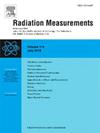Weighing options for passive environmental neutron dosimetry: A comparative study of PADCs, TLDs, OSLDs, and fission track detectors
IF 2.2
3区 物理与天体物理
Q2 NUCLEAR SCIENCE & TECHNOLOGY
引用次数: 0
Abstract
This study aims to evaluate the potential of polyallyl diglycol carbonate (PADC) detectors, coupled with LiF converters, for passive environmental neutron dosimetry. Their performance is compared against three other methods, fission track detectors, thermoluminescent detectors (TLDs), and optically stimulated luminescence detectors (OSLDs), to determine their viability for passive routine neutron monitoring in environmental settings.
The four detector types investigated (PADCs, fission tracks, TLDs and OSLDs) were placed in a moderator sphere and exposed to an AmBe neutron field. The measurements evaluated the dose response, measurement range, and precision of each system.
Results confirm that the advantage of the track detectors (PADC or fission track) is their gamma insensitivity: the TLD and OSLD methods require the combination of neutron-sensitive with neutron-insensitive detectors, as both are gamma-sensitive. This translated into a detection limit =6 μ Sv for PADC detectors coupled with LiF converters, comparable to that of fission track detectors (3 μ Sv). In contrast, the gamma-sensitive luminescence systems showed a detection limit of 10 μ Sv for the TLDs and 180 μ Sv for the OSLDs under AmBe neutron irradiations. This worsens under simulated environmental conditions, where a significant gamma contribution is expected, as demonstrated by a test where mixed gamma/neutron irradiation was used.
These results indicate the potential of the PADC coupled with a LiF converter system as a robust alternative to fission track detectors for passive environmental neutron dosimetry.
被动环境中子剂量计的称重选择:padc、tld、osld和裂变径迹探测器的比较研究
本研究旨在评估PADC(聚烯丙基二甘醇碳酸酯)探测器和6liff转换器在被动环境中子剂量测定中的应用潜力。将它们的性能与其他三种方法(裂变径迹探测器、热释光探测器(tld)和光激发发光探测器(osld))进行比较,以确定它们在环境设置中被动常规中子监测的可行性。所研究的四种探测器类型(padc、裂变径迹、TLDs和osld)被放置在慢化剂球中并暴露在AmBe中子场中。测量评估了每个系统的剂量反应、测量范围和精度。结果证实了径迹探测器(PADC或裂变径迹)的优点是它们的伽马不敏感:TLD和OSLD方法需要中子敏感和中子不敏感探测器的结合,因为两者都是伽马敏感的。这意味着与6LiF转换器耦合的PADC探测器的检测极限H * (10)=6 μ Sv,与裂变径迹探测器的检测极限(3 μ Sv)相当。相比之下,在AmBe中子辐照下,伽马敏感发光系统对TLDs的检测限为10 μ Sv,对OSLDs的检测限为180 μ Sv。在模拟环境条件下,这种情况会恶化,因为在模拟环境条件下,使用混合伽马/中子辐照的测试表明,伽马对辐射的贡献很大。这些结果表明,PADC与6LiF变换器系统耦合的潜力,作为被动环境中子剂量测定的裂变径迹探测器的强大替代品。
本文章由计算机程序翻译,如有差异,请以英文原文为准。
求助全文
约1分钟内获得全文
求助全文
来源期刊

Radiation Measurements
工程技术-核科学技术
CiteScore
4.10
自引率
20.00%
发文量
116
审稿时长
48 days
期刊介绍:
The journal seeks to publish papers that present advances in the following areas: spontaneous and stimulated luminescence (including scintillating materials, thermoluminescence, and optically stimulated luminescence); electron spin resonance of natural and synthetic materials; the physics, design and performance of radiation measurements (including computational modelling such as electronic transport simulations); the novel basic aspects of radiation measurement in medical physics. Studies of energy-transfer phenomena, track physics and microdosimetry are also of interest to the journal.
Applications relevant to the journal, particularly where they present novel detection techniques, novel analytical approaches or novel materials, include: personal dosimetry (including dosimetric quantities, active/electronic and passive monitoring techniques for photon, neutron and charged-particle exposures); environmental dosimetry (including methodological advances and predictive models related to radon, but generally excluding local survey results of radon where the main aim is to establish the radiation risk to populations); cosmic and high-energy radiation measurements (including dosimetry, space radiation effects, and single event upsets); dosimetry-based archaeological and Quaternary dating; dosimetry-based approaches to thermochronometry; accident and retrospective dosimetry (including activation detectors), and dosimetry and measurements related to medical applications.
 求助内容:
求助内容: 应助结果提醒方式:
应助结果提醒方式:


